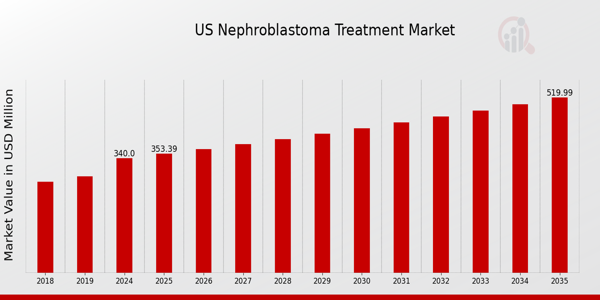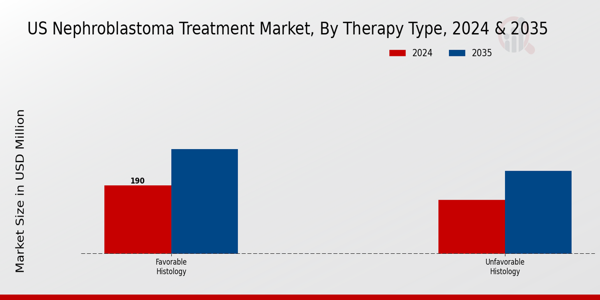US Nephroblastoma Treatment Market Overview
As per MRFR analysis, the US Nephroblastoma Treatment Market Size was estimated at 318.5 (USD Million) in 2023. The US Nephroblastoma Treatment Market Industry is expected to grow from 340(USD Million) in 2024 to 520 (USD Million) by 2035. The US Nephroblastoma Treatment Market CAGR (growth rate) is expected to be around 3.938% during the forecast period (2025 - 2035).
Key US Nephroblastoma Treatment Market Trends Highlighted
The US Nephroblastoma Treatment Market is characterized by several notable market trends, driven largely by advancements in treatment protocols and increased research funding. One of the key market drivers includes the rising incidence of nephroblastoma, also known as Wilms tumor, among children, which has led to greater emphasis on effective treatment modalities. Advances in surgical techniques, chemotherapy regimens, and the introduction of targeted therapies contribute to improved patient outcomes. The growing focus on early diagnosis, along with enhanced awareness among parents and healthcare providers about pediatric cancers, is further driving the demand for specialized treatments.
Opportunities to be explored in this market include the integration of personalized medicine into treatment protocols, which tailors therapies to individual patient needs based on genetic and molecular profiling. This approach not only enhances treatment efficacy but also reduces potential side effects, making it an attractive option for parents and healthcare providers. Additionally, collaboration between academic institutions and pharmaceutical companies can lead to innovative treatment options entering the market, capitalizing on the unmet needs within the field.
In recent times, initiatives by the National Cancer Institute and other health organizations in the US have led to increased funding for research on nephroblastoma, aiming to identify new treatment targets and improve existing therapies. This growing investment in research is expected to foster innovations, such as immunotherapy and new biomarker identification, which may significantly alter treatment paradigms in the near future. The focus on patient-centered care and shared decision-making is also shaping treatment approaches, reflecting broader trends in the healthcare industry towards improving quality of life for young patients battling nephroblastoma.

Source: Primary Research, Secondary Research, Market Research Future Database and Analyst Review
US Nephroblastoma Treatment Market Drivers
Rising Incidence of Nephroblastoma among Children
The US Nephroblastoma Treatment Market Industry is driven by a noticeable increase in the incidence of nephroblastoma, also known as Wilms tumor, among children. According to the American Cancer Society, there were about 500 new cases of nephroblastoma diagnosed in the United States in 2020, and this figure has been showing a gradual increase over the past few years. This raise in incidence necessitates improved treatment options, which not only defines the market landscape but also attracts investments.
Organizations such as the National Cancer Institute are actively engaging in Research and Development (R&D) efforts aimed at innovative treatment modalities, which can further accelerate market growth. Factors such as the need for advanced therapies and the urge to reduce mortality rates are likely to push the revenue trajectory upwards as awareness and diagnosis improve, indicating a promising future for the US Nephroblastoma Treatment Market.
Advancements in Treatment Technologies
Recent advancements in treatment technologies significantly contribute to the growth of the US Nephroblastoma Treatment Market Industry. Innovative surgical techniques, targeted therapies, and radiological advancements have revolutionized patient care. Reports indicate that new imaging technologies reduce diagnostic errors and enhance treatment efficacy, leading to better patient outcomes. Companies like Children's Oncology Group are at the forefront of clinical trials, exploring new treatments aimed at improving survival rates.
As technological integrations lead to more effective treatment plans, healthcare providers and institutions are more likely to adopt these latest innovations, which will boost overall market growth.
Increasing Funding for Pediatric Cancer Research
A notable driver for the US Nephroblastoma Treatment Market Industry is the increasing funding dedicated to pediatric cancer research. In 2021 alone, federal funding for children's cancer research programs rose significantly, with the National Institute of Health allocating more than 250 million USD towards various pediatric cancer studies. This influx of financial resources allows for expansive Research and Development (R&D) initiatives, aiming to discover novel therapies tailored specifically for nephroblastoma.
Organizations like the Pediatric Cancer Research Foundation are instrumental in channeling support towards clinical research, giving stakeholders a solid assurance that the market can expect breakthroughs in treatment efficacy, while fostering a competitive environment.
Growing Awareness and Advocacy for Pediatric Cancer
Growing awareness and advocacy for pediatric cancer significantly contribute to the US Nephroblastoma Treatment Market Industry. Increased campaigns led by organizations such as CureSearch for Children’s Cancer aim to educate the public and healthcare providers about childhood cancers, including nephroblastoma. Research indicates a 30% increase in awareness initiatives over the past five years.
As more families become informed about the signs and treatment options for nephroblastoma, early diagnosis is likely to improve, subsequently calling for a diverse range of therapeutic approaches. This heightened awareness will likely correlate with increased demand for nephroblastoma treatment solutions, thereby boosting the market dynamics.
US Nephroblastoma Treatment Market Segment Insights
Nephroblastoma Treatment Market Therapy Type Insights
The US Nephroblastoma Treatment Market, which is primarily categorized by Therapy Type, showcases a critical landscape in the treatment of kidney tumors associated with pediatric oncology. Among these treatment categories, the distinction between Favorable Histology and Unfavorable Histology, particularly Anaplastic Wilms Tumor, plays a vital role in treatment protocols and patient outcomes. Favorable Histology refers to tumors that exhibit a more positive response to treatment, leading to higher survival rates and often less aggressive therapeutic approaches.
This segment is significant as it accounts for a majority of cases diagnosed in children, emphasizing the need for tailored treatment plans that consider histological characteristics and overall patient health.
On the other hand, Unfavorable Histology, specifically Anaplastic Wilms Tumor, presents a more complex challenge in treatment due to its aggressive nature and poorer prognosis. This sub-segment demands advanced treatment strategies, which typically involve a multidisciplinary approach combining surgery, chemotherapy, and in certain cases, radiation therapy, aimed at enhancing survival rates while managing potential adverse effects. The variation in histology underscores the importance of precise diagnostics in determining the most effective treatments.
The US Nephroblastoma Treatment Market data reflects a growing emphasis on research aimed at improving treatment outcomes for both categories, with increasing investments in innovative therapies and clinical trials that target the more challenging aspects of Unfavorable Histology. Moreover, with ongoing advancements in precision medicine and genomics, the differentiation between these histological types gains even further importance, paving the way for customized and proactive treatment options tailored to individual patient needs.
Overall, the landscape of the Therapy Type segment in the US Nephroblastoma Treatment Market highlights the significance of histological classifications in ensuring optimal treatment approach, improving patient survival rates, and addressing the unique challenges posed by different tumor types in clinical settings.

Source: Primary Research, Secondary Research, Market Research Future Database and Analyst Review
Nephroblastoma Treatment Market Distribution Channel Insights
The Distribution Channel segment of the US Nephroblastoma Treatment Market plays a crucial role in ensuring that essential treatments are accessible to patients. Hospital pharmacies are particularly significant, as they often serve as the first point of medication availability for inpatients requiring nephroblastoma treatment, facilitating timely administration of life-saving therapies. Retail pharmacies and drug stores cater to outpatients, providing convenient access to medications and supporting ongoing treatment needs, which is vital for maintaining adherence and improving patient outcomes.
The growing trend towards E-Commerce offers a burgeoning opportunity for the market, allowing for increased accessibility of medications, especially in remote areas where physical pharmacies may not be readily available.
Additionally, the 'Others' category includes various specialized distribution methods that address specific patient needs, such as home delivery services, which have become particularly important in light of recent shifts toward at-home healthcare solutions. This multifaceted distribution approach addresses the varying needs of patients across the United States, positioning the market for sustained growth as it adapts to changing healthcare landscapes and consumer preferences.
Nephroblastoma Treatment Market Insights
The US Nephroblastoma Treatment Market includes critical segments such as Chemotherapy, Surgery, Radiation Therapy, and Others, each playing a pivotal role in managing this pediatric kidney cancer. Chemotherapy is widely utilized as a primary treatment modality, key in reducing tumor size and aiding surgical outcomes. Surgery remains a cornerstone, often employed to completely remove the tumor and surrounding affected tissues, showcasing its significance in achieving long-term survival.
Radiation Therapy, although not the frontline treatment, is sometimes necessary for residual disease management, highlighting its role in comprehensive care. Other therapeutic approaches, including clinical trials and supportive care, also contribute to the diverse treatment landscape. The increasing focus on individualized treatment plans and advancements in medical technologies are driving innovation across the market. Additionally, the growing incidence rates of nephroblastoma in children, combined with rising awareness and diagnostic capabilities, offer opportunities for heightened market engagement and expansion in the US.
Understanding each segment's contributions provides valuable insights into the overall dynamics of the US Nephroblastoma Treatment Market, shaping future strategies for improved patient outcomes.
Nephroblastoma Treatment Market Drug Insights
The US Nephroblastoma Treatment Market, specifically within the Drug segment, plays a crucial role in managing this rare pediatric cancer. Drugs such as Dactinomycin, Doxorubicin, and Vincristine are integral in the treatment protocols for nephroblastoma, being pivotal in chemotherapy regimens that target tumor reduction before surgical intervention. Cyclophosphamide and Etoposide also contribute significantly, often utilized in combination therapies to enhance treatment efficacy. Irinotecan has emerged as a noteworthy option in certain scenarios, reflecting ongoing advancements in treatment options available for patients.
The prevalence of nephroblastoma in the US necessitates the continuous evaluation of these drugs as researchers and healthcare professionals strive to optimize treatment outcomes. The US government and medical institutions frequently assess drug effectiveness and safety, ensuring that treatment regimens remain updated in accordance with the latest clinical findings. Overall, the Drug segment represents a dynamic landscape influenced by both established therapies and emerging treatment approaches, underscoring its importance in the overarching strategy for managing nephroblastoma.
Nephroblastoma Treatment Market Diagnosis Insights
The Diagnosis segment of the US Nephroblastoma Treatment Market plays a crucial role in the early detection and accurate assessment of the disease. This segment comprises various diagnostic tools such as Ultrasound, Computerized Tomography (CT), Magnetic Resonance Imaging (MRI), Chest X-Ray, Bone Scan, Lab Tests, and others, each offering pivotal insights into tumor characteristics and body location. Among these, Ultrasound is frequently utilized due to its non-invasive nature, making it particularly valuable in pediatric applications.
CT and MRI scans provide detailed imaging, essential for staging the cancer and formulating treatment plans, thereby supporting improved patient outcomes. Chest X-Ray and Bone Scans are instrumental in assessing metastasis, while Lab Tests help in identifying specific biomarkers that guide clinical decisions.
The significant variety within this segment ensures comprehensive diagnostic coverage, catering to the diverse needs of healthcare professionals in the US. As the US fosters advancements in imaging technology, the importance of precise diagnostic methods increases, highlighting a continuous trend toward enhanced early detection and patient management in nephroblastoma treatment.
Nephroblastoma Treatment Market End User Insights
The US Nephroblastoma Treatment Market has recognized the End User segment as a crucial aspect of its structure, comprising Hospitals, Cancer Centers, and Ambulatory Surgical Centers. Hospitals play a pivotal role in delivering comprehensive care for nephroblastoma patients, often serving as the initial point of diagnosis and treatment, thereby facilitating early intervention.
Cancer Centers are specifically designed to focus on oncology, providing specialized treatment protocols and advanced therapies that significantly enhance patient outcomes.
Meanwhile, Ambulatory Surgical Centers contribute to the market by offering outpatient surgical options, allowing for less invasive procedures and promoting quicker recovery times for patients. This segmentation reflects the varied landscape of cancer treatment delivery in the US, where access to specialized care is paramount. The growth in this market segment is driven by increasing incidences of nephroblastoma, ongoing advancements in treatment modalities, and rising awareness among healthcare professionals and patients regarding the importance of timely and effective treatment.
As these facilities adapt to changes in treatment protocols and incorporate emerging technologies, they are likely to continually influence the dynamics of the US Nephroblastoma Treatment Market.
US Nephroblastoma Treatment Market Key Players and Competitive Insights
The US Nephroblastoma Treatment Market exhibits significant competitive dynamics, driven by a combination of factors including advancements in medical technology, the emergence of innovative treatment options, and an increasing understanding of disease pathology. Nephroblastoma, primarily affecting children, has seen a surge in targeted therapies and research aimed at improving patient outcomes. The competitive landscape is characterized by pharmaceutical companies leveraging their R&D capabilities to spearhead solutions that not only enhance treatment efficacy but also minimize adverse effects.
This has led to heightened collaboration between industry players and academic institutions, fostering a robust innovation ecosystem focused on driving breakthroughs in nephroblastoma treatments.
Merck and Co has established a strong foothold in the US Nephroblastoma Treatment Market through its commitment to research and development, coupled with a robust pipeline that reflects its focus on oncology. The company's strength lies in its comprehensive approach toward drug development, which encompasses not only the creation of therapeutic agents but also strategic partnerships that augment its market reach and reinforce its position. Merck's portfolio showcases its capacity to provide innovative treatment options, fueled by extensive clinical trials that showcase efficacy.
This dedication to advancing treatment options puts Merck in a prominent position within the US nephroblastoma landscape, as it continues to navigate the complexities of pediatric oncology and address evolving patient needs.
Genentech, a key player in the US Nephroblastoma Treatment Market, is recognized for its leading-edge therapies, particularly in the realm of targeted biologics. The company’s portfolio includes key products aimed at improving survival rates and quality of life for young patients afflicted with nephroblastoma. Genentech’s presence in the market is reinforced by its investment in clinical research and collaborations, significantly enhancing its reputation. The company has attained strengths in offering tailored treatment regimens and actively participates in numerous clinical trials to explore additional therapeutic applications.
Moreover, recent mergers and acquisitions have bolstered Genentech’s capabilities, allowing for a more expansive approach to market needs while ensuring access to a wider array of treatments, thus establishing itself as an innovative leader in the US nephroblastoma treatment domain.
Key Companies in the US Nephroblastoma Treatment Market Include
- Regeneron Pharmaceuticals
US Nephroblastoma Treatment Market Industry Developments
Recent developments in the US Nephroblastoma Treatment Market have highlighted the competitive landscape among major pharmaceutical companies. Notably, Merck and Co continues to innovate in pediatric oncology treatments, while Genentech is pushing forward with targeted therapies that show promise for nephroblastoma.
As of August 2023, Celgene, now part of Bristol-Myers Squibb, reported advancements in immunotherapy approaches that may benefit pediatric oncology, enhancing treatment outcomes for nephroblastoma patients. AstraZeneca and Novartis have also been involved in partnerships focusing on research initiatives aimed at understanding the genetic underpinnings of nephroblastoma to optimize therapies.
The US market valuation for nephroblastoma treatments has seen a marked increase due to growing investments in Research and Development by major players like Eli Lilly and Company, Pfizer, and Amgen, which is projected to enhance treatment accessibility and efficacy.
Additionally, in September 2022, Roche announced a strategic acquisition aimed at strengthening its oncology portfolio, directly impacting nephroblastoma treatment options in the US. Such advancements reflect a dynamic market responding to both scientific and clinical needs, enhanced by collaborations among leading industry players and healthcare institutions.
US Nephroblastoma Treatment Market Segmentation Insights
Nephroblastoma Treatment Market Therapy Type Outlook
- Unfavorable Histology (Anaplastic Wilms Tumor)
Nephroblastoma Treatment Market Distribution Channel Outlook
Nephroblastoma Treatment Market Outlook
Nephroblastoma Treatment Market Drug Outlook
- Vincristine (Vincasar Pfs, Oncovin)
- Cyclophosphamide (Cytoxan, Neosar)
- Etoposide (Toposar, Vepesid)
Nephroblastoma Treatment Market Diagnosis Outlook
- Computerized Tomography (CT)
Magnetic Resonance Imaging (MRI)
Nephroblastoma Treatment Market End User Outlook
- Ambulatory Surgical Centers
| Report Attribute/Metric Source: |
Details |
| MARKET SIZE 2018 |
318.5(USD Million) |
| MARKET SIZE 2024 |
340.0(USD Million) |
| MARKET SIZE 2035 |
520.0(USD Million) |
| COMPOUND ANNUAL GROWTH RATE (CAGR) |
3.938% (2025 - 2035) |
| REPORT COVERAGE |
Revenue Forecast, Competitive Landscape, Growth Factors, and Trends |
| BASE YEAR |
2024 |
| MARKET FORECAST PERIOD |
2025 - 2035 |
| HISTORICAL DATA |
2019 - 2024 |
| MARKET FORECAST UNITS |
USD Million |
| KEY COMPANIES PROFILED |
Merck and Co, Genentech, Celgene, Novartis, AstraZeneca, BristolMyers Squibb, Eli Lilly and Company, Regeneron Pharmaceuticals, Pfizer, Amgen, Roche, AbbVie, Johnson and Johnson, GSK, Bayer |
| SEGMENTS COVERED |
Therapy Type, Distribution Channel, , Drug, Diagnosis, End User |
| KEY MARKET OPPORTUNITIES |
Improved targeted therapies development, Increased clinical trial investments, Enhanced diagnostic technologies integration, Growing patient awareness programs, Rising collaborations among research institutes |
| KEY MARKET DYNAMICS |
increasing incidence rates, advancements in treatment modalities, rising healthcare expenditure, growing awareness and screening, strategic partnerships and collaborations |
| COUNTRIES COVERED |
US |
Frequently Asked Questions (FAQ):
The US Nephroblastoma Treatment Market is expected to be valued at 340.0 million USD in 2024.
By 2035, the market is projected to reach 520.0 million USD.
The expected CAGR for the US Nephroblastoma Treatment Market from 2025 to 2035 is 3.938%.
The market segment for Favorable Histology is expected to hold a larger share, valued at 190.0 million USD in 2024.
The market value for Unfavorable Histology is expected to reach 230.0 million USD by 2035.
Key players include Merck and Co, Genentech, Celgene, Novartis, and AstraZeneca among others.
Growth drivers include advancements in therapy options and increasing awareness about nephroblastoma.
By 2035, the market segmentation will continue to focus on therapy types, particularly Favorable and Unfavorable Histology.
The market faces challenges such as regulatory hurdles and competition from emerging treatment alternatives.
The overall growth outlook remains positive with a steady increase driven by research and innovation.















